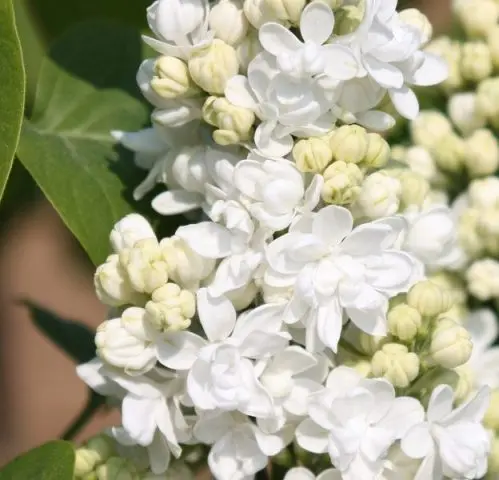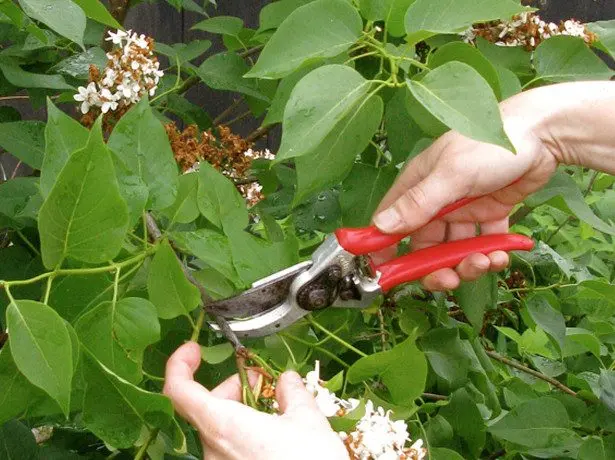Contents
Photos and descriptions of Madame Lemoine’s lilacs allow you to get acquainted with the culture in detail. Fragrant bushes blooming in late spring leave few indifferent, and this variety is distinguished by especially lush and long flowering, which peaks in mid-summer. This is the most famous variety of all types of white lilacs with double flowers.
Description of the lilac Madame Lemoine
The lilac bush reaches a height of 3-4 m, the diameter of its spreading crown is about 3 m. The branches grow vertically upwards, have dense bright green foliage that does not change color in autumn. The leaf plate is large, 6–11 cm long, dense, heart-shaped. The shrub grows quite quickly – the annual growth is about 20 cm. The bark on the trunk and old branches is dark gray, young shoots are characterized by a yellowish or olive tint.
How the lilac blooms Madame Lemoine
This variety belongs to late-flowering – abundant and prolonged flowering of the shrub occurs in June-July. The buds are large, creamy, the blossoming flowers are large, up to 2,6 cm in diameter, pure white, with a pronounced pleasant smell. Terry flowers, consisting of 2-3 corollas, are collected in dense inflorescences about 30×30 cm in size. Each inflorescence contains 1-2 pairs of strong panicles.
The bush reaches its maximum decorativeness by 10–12 years.

Features of reproduction
Lilac Madame Lemoine is propagated by grafting, cuttings and layering. Distillation from seeds is also possible, but this method does not justify itself.
Lilac is grafted with a dormant bud or cutting to Hungarian lilac, common lilac or common privet.
The success of propagation by cuttings depends on compliance with the temperature regime and humidity requirements.
The most common way to get a young plant is rooting cuttings. The lower branches of the mother bush are placed in grooves specially dug in the ground and sprinkled with soil. In a season, they will take root, and they can be transplanted.
Planting and caring for lilac Madame Lemoine
Madame Lemoine lilac is a relatively unpretentious shrub, but it is the choice of location and proper planting that determines how she will feel and how well she can show her decorative qualities.
Recommended dates
Both early spring and late autumn are suitable for planting Madame Lemoine, but many gardeners insist that the best time is after flowering has ended and until early September. During this period, the shrub does not waste energy on vigorous vegetation and flowering, and it has the opportunity to take root before the onset of frost.
Site selection and preparation of soil
Lilac Madame Lemoine prefers well-lit places, but also grows in partial shade. Low, waterlogged areas are not suitable for her. For the root system of this culture, the close occurrence of groundwater is detrimental.
Lilac does well in fertile, moderately moist, well-drained soils with a high humus content. An excellent option is loamy, slightly acidic or neutral soils.
How to plant
For better survival, it is recommended to plant lilacs in the evening in cloudy weather.
The lilac Madame Lemoine is planted in square pits with sheer walls. If the soil does not need preparation, a size of 50×50 cm is sufficient. Organic fertilizers and ash are poured onto the bottom. On poor soils, the pits are made twice as large and fill half the volume with a nutrient substrate from the excavated earth, humus, wood ash and superphosphate.
A seedling with a straightened root system or with an earthen clod is placed in a pit and covered with earth to the level of the root collar. Then the bush is abundantly watered and mulched. Within 2-4 years after planting, it can not be fertilized.
If you plant a plant in the spring, you need to remove all flower buds – so the lilac will put all its strength into rooting. When planting in autumn, it is enough to cut off only part of the kidneys.
Growing lilac Madame Lemoine
Growing lilacs is not very difficult. Like other varieties of lilacs, the Madame Lemoine variety withstands care errors, but the more effort the gardener puts into caring for him, the more spectacular the flowering will be. Watering, fertilizing, mulching and pruning are the main components of the proper cultivation of lilacs.
Watering
Lilac Madame Lemoine is moisture-loving. During the growing season and flowering, the amount of watering is increased, but water stagnation should not be allowed – thin roots may die. When the bush fades, watering is minimized so as not to provoke re-swelling of the kidneys. Seedlings are recommended to be watered more often than adult plants.
Additional fertilizing
Lilac varieties Madame Lemoine reacts to top dressing with increased growth and abundant flowering. Fertilization is subject to several rules:
- if a nutrient substrate was introduced into the pit when planting, the plant can not be fertilized for 2–3 years;
- the main fertilizer is organic (manure, compost, bird droppings). It is brought in within a radius of about half a meter from the bush;
- mineral fertilizers – potassium and phosphorus are applied once every few years in August;
- during the active growing season, you can spray the bush with an aqueous solution of mineral fertilizers;
- top dressing with ash dissolved in water is very useful.
Mulching
Mulching is a popular technique that makes it easier to care for lilacs. Using peat, sawdust or humus as a mulch immediately after planting helps the lilac take root better, providing the root system with additional nutrition. Mulching also helps retain moisture in the soil, prevents the growth of weeds and eliminates the need to regularly loosen the bush. In winter, this procedure protects the roots of young plants from severe frosts.
Trimming
Pruning lilacs is an important part of caring for a shrub of this variety. It has several subtleties:
- when the plant fades, the faded brushes are cut off, otherwise the buds will not form next year;
- if the plant needs rejuvenation, then the old branches should be cut out gradually, no more than 1-2 per year. This pruning is done in early spring;
- sanitary pruning is desirable to carry out 2 times a year – in spring and autumn, but you can do it at any time of the year. At the same time, all broken, dead or damaged shoots are removed;
- lilac Madame Lemoine does not need to form a bush, but many gardeners prefer to give it a sprawling shape, leaving only 6–10 of the most well-placed skeletal branches. This procedure is carried out until the kidneys swell;
- cut out all last year’s shoots that take food from skeletal branches;
- remove root suckers;
- so that the lilac does not grow old ahead of time, and flowering is plentiful every season, cut off part of the flower buds. So the plant does not spend all its energy on flowering and does not need to be restored next season.

Preparation for winter
Madame Lemoine lilac has a high winter hardiness and does not need shelter for the winter. Only seedlings can suffer from severe frosts, so the near-trunk circles of young bushes are mulched in the fall with a mixture of peat and leaves with a layer of up to 12 cm. In the spring, the mulch is removed so as not to interfere with the warming of the soil. Sometimes, with sudden changes in temperature, Madame Lemoine’s lilacs may freeze some branches. It does not pose a danger to the plant. They will need to be removed during sanitary pruning.
Diseases and pests
The varietal feature of Madame Lemoine lilac is its resistance to diseases and pests. However, sometimes it can also be affected by late blight of the kidneys and bacterial rot. Copper oxychloride and Bordeaux liquid help to cope with them. Specific pests of lilacs are lilac hawk moth and moth moth. To combat them, insecticides are used.
Conclusion
Photos and descriptions of lilacs by Madame Lemoine do not leave indifferent either professional landscape designers or amateur gardeners. This unusual variety looks great both as a single element and as part of various plant ensembles. Undemanding care will allow even a beginner to enjoy the long abundant flowering of this variety of lilacs.









